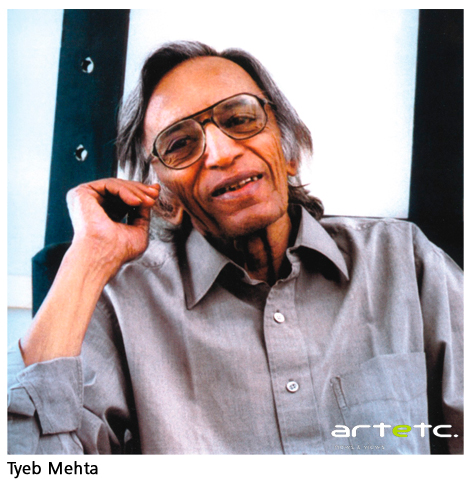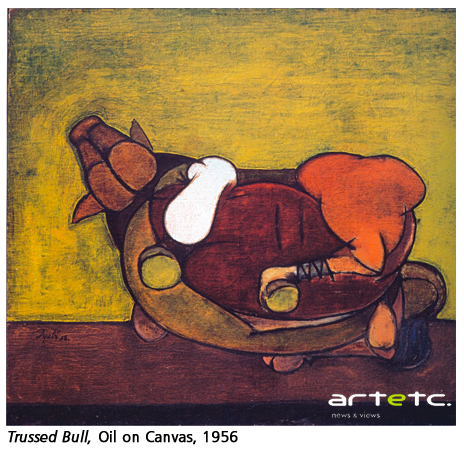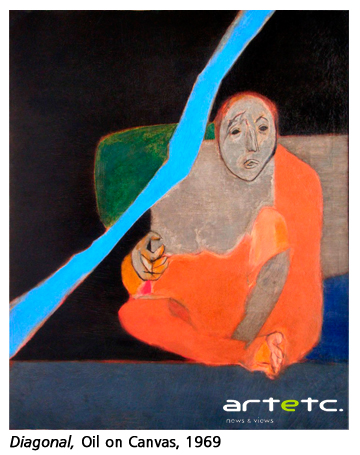- Publisher's Note
- Editorial
- The Enigma That was Souza
- Progressive Art Group Show: The Moderns
- The Souza Magic
- M.F. Husain: Other Identities
- From All, One; And From One, All
- Tyeb Mehta
- Akbar Padamsee: The Shastra of Art
- Sensuous Preoccupations of V.S. Gaitonde
- Manishi Dey: The Elusive Bohemian
- Krishen Khanna: The Fauvist Progressive
- Ram Kumar: Artistic Intensity of an Ascetic
- The Unspoken Histories and Fragment: Bal Chhabda
- P. A. G. and the Role of the Critics
- Group 1890: An Antidote for the Progressives?
- The Subversive Modernist: K.K.Hebbar
- Challenging Conventional Perceptions of African Art
- 40 Striking Indian Sculptures at Peabody Essex Museum
- Tibetan Narrative Paintings at Rubin Museum
- Two New Galleries for the Art of Asia opens at the Museum of Fine Arts in Boston
- Raphael, Botticelli and Titian at the National Gallery of Australia
- The Economics of Patronization
- And Then There Was Zhang and Qi
- What Happened and What's Forthcoming
- Random Strokes
- Yinka Shonibare: Lavishly Clothing the Somber History
- A Majestic “Africa”: El Anatsui's Wall Hangings
- The Idea of Art, Participation and Change in Pistoletto’s Work
- On Wings of Sculpted Fantasies
- The Odysseus Journey into Time in the Form of Art
- On Confirming the Aesthetic of Spectacle: Vidya Kamat at the Guild Mumbai
- Dhiraj Choudhury: Artist in Platinum Mode
- Emerging from the Womb of Consciousness
- Gary Hume - The Indifferent Owl at the White Cube, London
- Daum Nancy: A Brief History
- Experimenting with New Spatial Concepts – The Serpentine Gallery Pavilion Project
- A Rare Joie De Vivre!
- Art Events Kolkata-December 2011– January 2012
- Art Bengaluru
- Mumbai Art Sighting
- Delhi Dias
- Musings from Chennai
- Preview, February, 2012- March, 2012
- In the News-January 2012
ART news & views
Tyeb Mehta
Issue No: 25 Month: 2 Year: 2012
by Uma Prakash

Tyeb Mehta's work over the last six decades made him one of the greatest names in Modern Indian Art. His paintings started a dialogue about the human conditions, revealing his deep empathy for the underdog. The breadth of the artist's achievements around the world and his list of international honours are remarkable. Through some of his work Mehta stresses the importance of the memory of the brutality that humans inflict on each other. A thinking artist it is only right that he makes our eyes and mind tussle with that which he had seen and felt.
Tyeb Mehta born in 1925 in Kapadvanj, Gujarat, grew up in Mumbai which was to later become his home. He worked as an editor at Famous Cine Laboratories and realized that his real passion was art. He enrolled at the country's leading institution, the Sir JJ School of Art in Mumbai. It was here that he met a group of artists who had started The Bombay Progressive Artists' Group the most influential group of modern artists in India. He described his camaraderie with fellow Progressives during the early days of Indian independence in his 2006 interview with Somini Sengupta for the New York Times: “There was no Indian modern tradition to turn to. One had to create from nowhere. We learned painting together by talking, by looking at each other's work, by criticizing, by appreciating.”
The Progressive Artists' Group combined Indian subject matter with Post-Impressionist colours, Cubist forms brusque, and expressionistic styles. The Progressive Artists' Group was formed by Francis Newton Souza and S. H. Raza. M. F. Husain and Manishi Dey were early members, others associated with the group included S. K. Bakre, Akbar Padamsee and Tyeb Mehta The group wanted to develop a visual language that would reflect the spirit of the new Independent India. To achieve this hey wished to break away from the revivalist nationalism established by the Bengal school of art and to encourage an Indian avant-garde, engaged at an international level. In 1950, Vasudeo S. Gaitonde, Krishen Khanna and Mohan Samant joined the Group. Because of the exodus of Souza and Raza to New York and Paris respectively the Group broke up but the artists remained friends for life.
Mehta went abroad to London and Paris for four months in 1954 to study Western art, and was inspired by the old masters and European modernists. From 1950-1960 his work revealed a brush textured, impasto-laden expressionism like he School of Paris. His refuges and survivors were very different from his later works. In 1956 Mehta's created the Rickshaw Pullers showing a figure reclining on a hand-pulled rickshaw depicted in blocks of grays, reds and saffron. During Mehta's annual summer holidays spent with his grandmother in Kolkata he encountered the rickshaw puller. His compassion for the ground poverty, struggle and torture of the rickshaw puller is evident in his painting.
 His next very powerful work was Trussed Bull. Mehta's was horrified by a visit to an abattoir. The artist saw the animals being tied up and then slaughtered, and the vision consumed him thereafter. The idea of such a strong animal rendered helpless reflected the trials of o mankind... "For me the trussed bull is a compulsive image. [...] It served as a metaphor for the violent struggles one experiences in life: [...] the bull is a powerful animal and when its legs are tied and it's thrown down, it is an assault on life itself." (Y. Dalmia, Tyeb Mehta: Beyond Narrative Painting, Art Heritage 9, New Delhi, 1989-90). They are considered his two most important works.
His next very powerful work was Trussed Bull. Mehta's was horrified by a visit to an abattoir. The artist saw the animals being tied up and then slaughtered, and the vision consumed him thereafter. The idea of such a strong animal rendered helpless reflected the trials of o mankind... "For me the trussed bull is a compulsive image. [...] It served as a metaphor for the violent struggles one experiences in life: [...] the bull is a powerful animal and when its legs are tied and it's thrown down, it is an assault on life itself." (Y. Dalmia, Tyeb Mehta: Beyond Narrative Painting, Art Heritage 9, New Delhi, 1989-90). They are considered his two most important works.
Mehta held his first solo at the Jehangir Art Gallery in Mumbai in 1959 after which he and his wife Sakina moved to London and lived there for five years. Mehta was strongly influenced by Francis Bacon, with whose paintings he became acquainted. He developed a more abstract style retaining his figure and the feeling of anguish. The artist lived in Delhi from 1965-1979 where he created a deep bond with Ebrahim Alkazi, Krishen Khanna, Ram Kumar and A Ramachandran.

Mehta's image consisted of canvases portraying the irregular shapes of the human form broken by uneven shapes of solid colour. He gave the figures the freedom to float in the canvas. He returned to India and what followed was his Diagonal series (1969 – 76). They were unusual and bold canvases depicting figures with horror-struck expression. As a black line ran through them they revealed distorted figures juxtaposing the past with the present. The colours and the bold combination of Mehta's figures create an impact that is difficult to forget. In 1967 Mehta did a brief stint in Baroda where he studied sculpture.
The writings of Malraux, Gide, Camus and Sartre impacted Mehta's way of thinking. The idea of freedom over necessity appealed to him. In his works he allowed his images to float to a tune that was free and liberated.
In 1968, Mehta spent a year in New York on a Rockefeller Foundation grant and was exposed to Minimalism for the first time. In an interview he said that his encounter with Minimalist art was a revelation. When he saw his first original [Barnett Newman], for example, he had such an incredible emotional response to it.... he became interested in using pure colour. Normally brush marks suggest areas of directions. He wanted to avoid all this to bring elements down to such a minimal level that the image alone would be sufficient to speak for itself.
After 1968 his figures appeared with a cinematic and animation style. The result was his depictions of Mahishasura, a mighty half-man, half-buffalo demon who was slain by the warrior goddess Durga. Flat planes of colour in the background accentuate the drama of a single figure or intertwined duo. His series of Mahishasura demonstrated different angles of the war between Durga and the demon. Mehta dramatic interpretation of this famous legend strikes the eye and imagination.
Mehta was invited to be an artist-in-residence at Tagore's Vishva Bharati University, Santiniketan 1983. He was enchanted by the Santhal's and went on to paint his famous Santiniketan Triptych (1985), a 4.5-meter-long canvas depicting the Charak festival of Santhal, with a teeming crowd under a blue sky. He was captivated by the simplicity of the Santhals who had the ability to be joyous and happy in spite of their struggle. They danced, sang and lived for the moment. By capturing the spirit. of the tribal priestess, a figure swinging from a hook and a playful animal Mehta reveals the essence of this community. There is a slice of deeply felt humanity, a moment of spiritual revelation in this work. He enjoyed the atmosphere of Santiniketan and befriended artists like K G Subramanyam, Sharbari Roy Choudhry and Somenath Hore.
After his trip to Santiniketan Goddess Kali became part pf his consciousness. H has always been attracted to the mother goddess...It's a primordial image...at Santiniketan in Bengal he could feel the presence of Kali everywhere. That Mehta's Kali is pregnant, and it is apparent because of the big bulge in her belly. Kali is the mother of the universe protecting the future by destroying the evil present... In spite of her grotesque appearance Mehta's Kali exudes an endearing quality because it is common knowledge that her destructive dance is in self-defense to destroy world's evils and she will always be the eternal mother.
 In his bold style Mehta's painted a series featuring the form of the Hindu goddess Kali. The drama created by the three Kali's painted in blue with a red protruding tongue is visually challenging art. It is their expression that tells different stories. Kali-1 (1988), appears to be content after she has devoured her victim. Kali-2 (1988) uses all her force to wrestle with her victim and Kali-3 (1989) has consumed her victim, and what is left is the shredded flesh held in her right hand. All three seem to be in a dance-like motion. In the Kali series Mehta reveal his drawing skills as he discards his earlier brushwork.
In his bold style Mehta's painted a series featuring the form of the Hindu goddess Kali. The drama created by the three Kali's painted in blue with a red protruding tongue is visually challenging art. It is their expression that tells different stories. Kali-1 (1988), appears to be content after she has devoured her victim. Kali-2 (1988) uses all her force to wrestle with her victim and Kali-3 (1989) has consumed her victim, and what is left is the shredded flesh held in her right hand. All three seem to be in a dance-like motion. In the Kali series Mehta reveal his drawing skills as he discards his earlier brushwork.
 Mehta's Falling Figure with Bird (1987), a contorted figure and white bird against a black ground stood out for its uniqueness and colours exuding a rare energy. What followed was Mehta's Celebration (1995), a five-meter-long canvas that evokes images of his famous the colours and composition of the Santiniketan Triptych. Here again he depicts a milieu that is festive and happy. The dancing women are meant to be a tribe of survivors who have overcome famine, flood and several obstacles. Theirs is a dance of life. The sheer vibrancy of the images reveals the intensity of colour, emotion and line.
Mehta's Falling Figure with Bird (1987), a contorted figure and white bird against a black ground stood out for its uniqueness and colours exuding a rare energy. What followed was Mehta's Celebration (1995), a five-meter-long canvas that evokes images of his famous the colours and composition of the Santiniketan Triptych. Here again he depicts a milieu that is festive and happy. The dancing women are meant to be a tribe of survivors who have overcome famine, flood and several obstacles. Theirs is a dance of life. The sheer vibrancy of the images reveals the intensity of colour, emotion and line.
Mehta was a quiet man who lived simply. He was his own critic and was a very exacting person who maintained a very high standard for himself having destroyed many canvases in the process of creating a painting. Mehta was initially trained as a cinematographer and a film editor, and won him the Film fare Critic's Award in 1970. for his 1970 black-and-white film Koodal, which he shot in a Mumbai slaughterhouse.
Mehta's brutal anguished figures were the outcome of the horrors of Partition he had witnessed on the streets of Mumbai. Mehta produced works that are now benchmarks of Indian modernism celebrated today as influential works of Indian art. He is the inspiration and guide for many artist of the younger generation, making him a kind of national hero.
Recognition came to him when he was in his 60's. In 1988, he was awarded the Kalidas Samman, for his outstanding contributions to the arts. In 1994, SH Raza included him in “Seven Indian Painters” at Paris' Gallery Le Monde de l'Art. Mehta won the Dayawati Modi Foundation Award for Art, Culture and Education in 2005, and in 2007 the Padma Bhushan, the third-highest civilian award given by the Indian government for distinguished service.
Retaining an inimitable Tyeb Mehta used a few images, which have been worked at in different situation. The most significant ones are the trussed bull, Kali the falling figure, the diagonal cutting across these works. Mehta was influenced by French Modernism. The anguish displayed in his work reflected his own experiences from the struggle within oneself and the dreadful memory of a man whose death Mehta had seen during the India-Pakistan partition. It also displayed the horror of the partition followed by the state of turmoil in the sub-continent which still continues.
India lost a great artist when Mehta passed away in 2009. He is survived by his wife, son and daughter. His contribution to Indian is most significant as his works are thought provoking with subtle nuances. Mehta, an artist of great prominence displayed a rare sensitivity and empathy in his works.